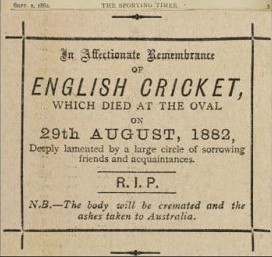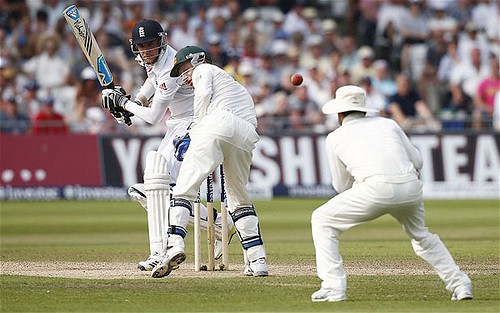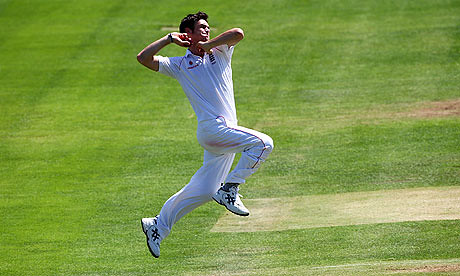Now that you're all experts in the distinctions between silly mid off and square leg, and can recite the lbw rules by heart, let's spend some time looking at the culture of the game. It's particularly appropriate that I should be blogging about cricket right now, because we are currently two glorious games into the most famous grudge match in cricket - The Ashes, an approximately biennial series of test matches played between England and Australia which is one the greatest sporting rivalries in the world. (No really. More famous even than the Montreal Canadiens vs. the Boston Bruins). The story of the Ashes is a good one; let's let Wikipedia give us the highlights:
It's difficult to overstate the importance of The Ashes to English and Australian cricket fans. Perhaps an imperfect analogy will illustrate the point: imagine that during the 1972 Summit Series, Russia had unexpectedly won the final and deciding game on Canadian ice. And then suppose they got really snotty about it and proclaimed the "death of Canadian hockey" and burned a hockey stick and put it into a little urn. And then suppose that urn full of "The Ashes" had been fought over every two years since, with the rivalry growing more bitter with every passing series. See what I mean? Important. Actually, more important than that even, because the rivalry between England and Australia is something that really has no analogy for Canadians. There's a bitterness about the struggle between the upstart antipodean colonials and their former masters that just never materialised in Canada. This is likely because the Aussies are generally consummately successful at almost any sport they try, and because the English were kind of rubbish for a long time, and because the Aussies are maybe not the most sporting winners, and the English are used to being moaning losers and… well it's complicated. I'll just say it again, The Ashes are IMPORTANT.
The Ashes is traditionally is series of five test matches, each of which can last for up to five days. Taking into account rests between matches, this means an Ashes series is rather a marathon. This year the first test started on July 10 and the fifth day of the fifth match is scheduled for August 25. And as I write this England are in very good shape indeed. They've won the first two matches, the second of which was nothing short of a complete disaster for the Aussies, with England winning by 347 runs, a rather crushing margin.
There's been a bit of controversy this year too. Cricket is seen very much as a gentleman's game. Players are meant to be gracious winners and good losers. The laws of the game even include a preamble about "The Spirit of Cricket", which is seen as a crucial part of the game. In fact, the phrase "it's just not cricket" is used to describe anything (not just in sport) that's unfair or unsportsmanlike. Recently one unwritten law of cricket etiquette - "walking" - has been in the news. In cricket terms a players is said to "walk" if he leaves the pitch voluntarily after apparently being dismissed, without waiting for the umpire to confirm the dismissal. The idea is that the player knows he's out, and honourably leaves the game without having to be told. In recent years, more and more players have started to hang about on the off-chance that the umpire's decision might go their way which is seen by many as, well, just not cricket. The issue was in the news after the first Ashes test match when Stuart Broad, a prominent English player, refused to walk after he was caught out on ball that hit the edge of his bat. Untold acres of forest were milled into newsprint so that everyone in the country could hear every opinion, for and against, about Broad's refusal to walk.
Cricket has also given us a few good turns of phrase beside "it's not cricket". For instance when we say "I'm stumped" that comes from cricket. And when an older person dies instead of saying, "Well he had a long life" you might hear, "He had a good innings." And what about "sticky wicket" and "bowled over"? Thanks, cricket!
Of course like any other major sport, cricket has a pantheon of famous players stretching back through the ages. Perhaps the most famous was the Australian Sir Donald Bradman, who is widely regarded as the greatest batsman ever, retiring with an astonishing average of 99.94 for test cricket. Scoring 100 points in a single game is called a "century" and many cricketers never manage it once, let alone achieving an average of close to that. When I heard about that statistic I asked my housemate Jools about his last at bat and posited that, considering everyone knew he was about to retire and he was so close to averaging 100 for his career, would the English bowler perhaps not have tossed him an easy one? Jools was aghast and said, in her most offended voice, "It was TEST CRICKET Pam. Against AUSTRALIA!" (So you see what I mean about England vs. Australia?) Bradman's dominance was so complete that many consider him the greatest sportsman of all time, across all sports, though to counter this I would humbly submit the stats of Wayne Gretzky. (In fact, someone has, and has determined that Gretzky was bascially as great as Bradman. So there!)
As for bowling - it's definitely a black art. The action itself is different than baseball pitching. The bowler takes a long run up and bowls the ball overhand with an almost straight arm, and usually the ball bounces once in front of the batsman before it's hit. A lot of the art of bowling is in making the ball ping off in an odd direction after it bounces, making it harder for the batsman to hit. This is helped by the fact that a cricket ball has a wide, heavy seam running all the way around the ball, which affects the trajectory of the ball through the air and when it bounces. Fast bowlers fling the thing at great speeds (85-95 mph). Spin bowlers twist the ball when releasing to impart spin, which mean their deliveries are slower but can be remarkably tricky.
The condition of the ball also plays a big part in how it reacts, meaning that tampering with ball is a big no-no. And unlike baseball, if the ball is hit into the crowd it gets returned to play. A new ball is only allowed into the game under a few specific circumstances (if it's been lost or tampered with, or in test cricket, at the start of a new innings, and after 80 overs).
The other absolutely vital bit of English cricket culture I need to address is Test Match Special. TMS is the BBC radio coverage of professional cricket, which provides coverage and colour commentary on most matches involving the English national team. One might think that ball by ball coverage of the 45 hours of regulation play in an international test match could, just possibly, be a dull affair, and you would not be alone in that opinion. There is a percentage of the population that would rather listen to a dentist's drill. But for cricket fans Test Match Special, and its iconic theme tune are sacrosanct (think: Hockey Night in Canada). It's particularly noted for its commentators, who, as you might imagine, have a lot of time to talk about things other than cricket, since the game tends to unfold at what might charitably be called a leisurely pace. Henry Blofeld is particularly known for this, commenting on "things like construction cranes or numbers of pink shirts in the crowd; as well as pigeons, buses, aeroplanes and helicopters that happen to be passing by."
I tuned in to Test Match Special during the first test of this year's Ashes and it is a bit hypnotic. And I felt that I'd just heard what must be the most particularly English few seconds of radio when Test Match Special cut away to the Shipping Forecast. It really doesn't get more English than that. Plus I got to write down this actual quote, which happened after two wickets had fallen in relatively quick succession (and by this I mean in less than half a day). Clearly agitated by the pace of the game the announcer said, with no trace of irony:
The series is the result of a satirical obituary published in a British newspaper, The Sporting Times, in 1882 after a match at the Oval in which Australia beat England on an English ground for the first time. The obituary stated that English cricket had died, and the body will be cremated and the ashes taken to Australia. The English media dubbed the next English tour to Australia (1882–83) as the quest to regain the Ashes.
The famous obituary
In the beginning there were no actual ashes, but shortly after a tiny urn containing the cremated remains of a bail became the focus of the contest. And when I say tiny, I do mean TINY, as you can see from this picture of England bowler James Anderson and Tim Bresnan after winning the Ashes 2011. After a long time in the sporting wilderness, England are having a bit of a heyday. They've won the last two Ashes series, had a cracking good Olympics, chalked up two consecutive wins in the Tour de France and finally (FINALLY) a British born player has won Wimbeldon. Heady days indeed. Add in unseasonably hot sunny weather and a new royal baby and people here are a bit giddy.
There's been a bit of controversy this year too. Cricket is seen very much as a gentleman's game. Players are meant to be gracious winners and good losers. The laws of the game even include a preamble about "The Spirit of Cricket", which is seen as a crucial part of the game. In fact, the phrase "it's just not cricket" is used to describe anything (not just in sport) that's unfair or unsportsmanlike. Recently one unwritten law of cricket etiquette - "walking" - has been in the news. In cricket terms a players is said to "walk" if he leaves the pitch voluntarily after apparently being dismissed, without waiting for the umpire to confirm the dismissal. The idea is that the player knows he's out, and honourably leaves the game without having to be told. In recent years, more and more players have started to hang about on the off-chance that the umpire's decision might go their way which is seen by many as, well, just not cricket. The issue was in the news after the first Ashes test match when Stuart Broad, a prominent English player, refused to walk after he was caught out on ball that hit the edge of his bat. Untold acres of forest were milled into newsprint so that everyone in the country could hear every opinion, for and against, about Broad's refusal to walk.
The infamous moment
Of course like any other major sport, cricket has a pantheon of famous players stretching back through the ages. Perhaps the most famous was the Australian Sir Donald Bradman, who is widely regarded as the greatest batsman ever, retiring with an astonishing average of 99.94 for test cricket. Scoring 100 points in a single game is called a "century" and many cricketers never manage it once, let alone achieving an average of close to that. When I heard about that statistic I asked my housemate Jools about his last at bat and posited that, considering everyone knew he was about to retire and he was so close to averaging 100 for his career, would the English bowler perhaps not have tossed him an easy one? Jools was aghast and said, in her most offended voice, "It was TEST CRICKET Pam. Against AUSTRALIA!" (So you see what I mean about England vs. Australia?) Bradman's dominance was so complete that many consider him the greatest sportsman of all time, across all sports, though to counter this I would humbly submit the stats of Wayne Gretzky. (In fact, someone has, and has determined that Gretzky was bascially as great as Bradman. So there!)
As for bowling - it's definitely a black art. The action itself is different than baseball pitching. The bowler takes a long run up and bowls the ball overhand with an almost straight arm, and usually the ball bounces once in front of the batsman before it's hit. A lot of the art of bowling is in making the ball ping off in an odd direction after it bounces, making it harder for the batsman to hit. This is helped by the fact that a cricket ball has a wide, heavy seam running all the way around the ball, which affects the trajectory of the ball through the air and when it bounces. Fast bowlers fling the thing at great speeds (85-95 mph). Spin bowlers twist the ball when releasing to impart spin, which mean their deliveries are slower but can be remarkably tricky.
A bowler about to release the ball
A shiny new cricket ball. It's made of cork covered in leather.
I tuned in to Test Match Special during the first test of this year's Ashes and it is a bit hypnotic. And I felt that I'd just heard what must be the most particularly English few seconds of radio when Test Match Special cut away to the Shipping Forecast. It really doesn't get more English than that. Plus I got to write down this actual quote, which happened after two wickets had fallen in relatively quick succession (and by this I mean in less than half a day). Clearly agitated by the pace of the game the announcer said, with no trace of irony:
"It's just drama. Every half an hour something happens."And that, dear friends, is cricket.








1 Comment:
Perfect, well almost = It's runs that are scored, not points :)
Post a Comment